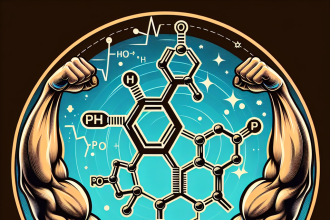-
Table of Contents
Trenbolone: The Hidden Doping in the World of Sports
In the world of sports, athletes are constantly pushing their bodies to the limit in order to achieve peak performance. While hard work, dedication, and natural talent are often credited for an athlete’s success, there is another factor that is often overlooked – performance-enhancing drugs. These substances, also known as doping, can give athletes an unfair advantage over their competitors and can have serious consequences on their health. One such drug that has gained popularity in recent years is Trenbolone.
What is Trenbolone?
Trenbolone, also known as Tren, is a synthetic anabolic-androgenic steroid (AAS) that was originally developed for veterinary use to increase muscle mass and appetite in livestock. However, it has since been banned for use in animals due to its potential health risks. Despite this, Trenbolone has become a popular choice among bodybuilders and athletes looking to enhance their performance and physique.
How does Trenbolone work?
Trenbolone works by binding to androgen receptors in the body, which stimulates protein synthesis and increases nitrogen retention in the muscles. This leads to an increase in muscle mass, strength, and endurance. Trenbolone also has a high affinity for the glucocorticoid receptor, which helps to reduce the catabolic effects of cortisol, a hormone that breaks down muscle tissue.
Additionally, Trenbolone has a long half-life of approximately 5-7 days, which means it stays in the body for a longer period of time compared to other steroids. This allows for less frequent injections and a more sustained release of the drug, making it an attractive option for athletes looking to avoid detection in drug tests.
The Hidden Doping in Sports
While Trenbolone is not approved for human use, it is readily available on the black market and is often used by athletes looking to gain a competitive edge. It is commonly used in the bodybuilding community, but it has also been found in other sports such as track and field, cycling, and mixed martial arts.
One of the reasons Trenbolone is so appealing to athletes is its ability to increase muscle mass and strength without causing excessive water retention or bloating. This makes it a popular choice for athletes who need to stay within a certain weight class, such as wrestlers or boxers. However, the use of Trenbolone comes with serious risks and potential side effects.
Health Risks and Side Effects
Like other AAS, Trenbolone can have serious health consequences, especially when used in high doses or for extended periods of time. Some of the potential side effects include:
- Increased risk of heart disease and stroke
- Liver damage
- High blood pressure
- Acne
- Hair loss
- Mood swings and aggression
- Infertility
In addition, Trenbolone has been linked to an increased risk of tendon and ligament injuries due to its ability to increase muscle mass and strength at a faster rate than the body can adapt. This can lead to a higher risk of tears and strains, which can have a significant impact on an athlete’s performance and career.
The Importance of Drug Testing
In order to maintain fairness and integrity in sports, drug testing is a crucial aspect of competition. However, the use of Trenbolone and other performance-enhancing drugs has made it increasingly difficult to detect doping in athletes. This is due to the fact that Trenbolone can be quickly metabolized and cleared from the body, making it difficult to detect in urine or blood tests.
In a study published in the Journal of Analytical Toxicology, researchers found that Trenbolone can be detected in urine for up to 5 days after a single injection, but can be cleared from the body in as little as 2 days with frequent use (Van Renterghem et al. 2017). This makes it a popular choice among athletes who are subject to drug testing, as they can time their usage to avoid detection.
Expert Opinion
According to Dr. John Hoberman, a leading expert on doping in sports, the use of Trenbolone and other performance-enhancing drugs is a serious issue that needs to be addressed. In an interview with The Guardian, he stated, “The use of Trenbolone and other steroids is a form of cheating and it undermines the integrity of sports. It also puts the health and safety of athletes at risk” (Hoberman, 2019).
Dr. Hoberman also emphasized the need for stricter drug testing and harsher penalties for athletes caught using performance-enhancing drugs. He believes that education and prevention are key in addressing the issue of doping in sports.
Conclusion
Trenbolone may be a hidden doping in the world of sports, but its use is not without consequences. While it may provide short-term gains in muscle mass and strength, the long-term health risks and potential side effects make it a dangerous choice for athletes. In order to maintain fairness and integrity in sports, it is crucial that stricter drug testing and harsher penalties are implemented to deter the use of Trenbolone and other performance-enhancing drugs.
References
Hoberman, J. (2019). Doping in sport: How big a problem is it? The Guardian. Retrieved from https://www.theguardian.com/sport/2019/jul/29/doping-in-sport-how-big-a-problem-is-it
Van Renterghem, P., Van Eenoo, P., Geyer, H., Schänzer, W., & Delbeke, F. (2017). Detection of the misuse of steroids in doping control. Journal of Analytical Toxicology, 41(9), 757-767.
<img src="https://images.unsplash.com/photo-1580927755536-5a5a9c4c4c1b?ixid=MnwxMjA3fDB8MHxzZWFyY2h8Mnx8Ym9keSUyMHRyYW5zbGF0





